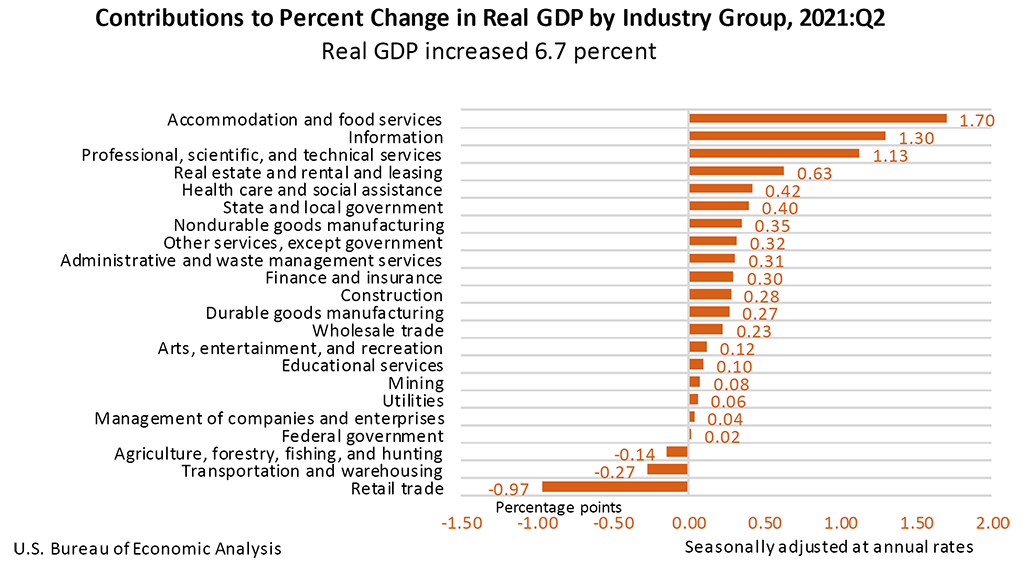Real gross domestic product (GDP) increased at an annual rate of 6.7 percent in the second quarter of 2021, reflecting the continued economic recovery, reopening of establishments, and continued government response related to the COVID-19 pandemic. The increase was revised up 0.1 percentage point from the “second” estimate released in August. In the second quarter, government assistance payments in the form of loans to businesses and grants to state and local governments increased, while social benefits to households, such as the direct economic impact payments, declined. In the first quarter of 2021, real GDP increased6.3 percent. For more details, including source data, see the Technical Note and Federal Recovery Programs and BEA Statistics.
GDP highlights
The second-quarter increase in real GDP reflected increases in consumer spending, business investment, and exports that were partly offset by decreases in inventory investment, housing investment, and federal government spending. Imports, a subtraction in the calculation of GDP, increased.
- The increase in consumer spending reflected increases in services (led by food services and accommodations) and goods (led by other nondurable goods, notably pharmaceutical products, as well as clothing and footwear).
- The increase in business investment reflected increases in equipment (led by transportation equipment) and intellectual property products (led by software as well as research and development).
- The increase in exports reflected an increase in goods (led by non-automotive capital goods) and services (led by travel).
- The decrease in inventory investment was led by a decrease in retail inventories.
- The decrease in federal government spending primarily reflected a decrease in nondefense spending on intermediate goods and services. In the second quarter, nondefense services decreased as the processing and administration of Paycheck Protection Program(PPP) loan applications by banks on behalf of the federal government declined.
Updates to GDP
The revision to GDP reflected upward revisions to consumer spending, exports, and inventory investment that were partly offset by an upward revision to imports.
Personal income and saving
Real disposable personal income (DPI)— personal income adjusted for taxes and inflation—decreased 30.2 percent in the second quarter, an upward revision of 0.8 percentage point from the second estimate.
The decrease in current-dollar DPI primarily reflected a decrease in government social benefits related to pandemic relief programs, notably direct economic impact payments to households established by the Coronavirus Response and Relief Supplemental Appropriations Act and the American Rescue Plan Act. Personal saving as a percent of DPI was 10.5 percent in the second quarter, compared with 20.5 percent in the first quarter.
Corporate profits from current production
Profits increased10.5 percent at a quarterly rate in the second quarter after increasing 5.1 percent in the first quarter.
- Profits of domestic nonfinancial corporations increased 13.8 percent after increasing 9.1 percent.
- Profits of domestic financial corporations increased 10.9 percent after increasing 0.3 percent.
- Profits from the rest of the world decreased 1.3 percent after decreasing 2.2 percent.
Corporate profits increased45.1 percent in the second quarter from one year ago.
Gross domestic product by industry
Today’s release includes estimates of GDP by industry, or value added—a measure of an industry’s contribution to GDP. Private goods producing industries increased 4.7 percent, private services-producing industries increased 7.8 percent, and government increased3.4 percent. Overall, 19 of 22 industry groups contributed to the second quarter increase in real GDP.
- The increase in private goods-producing industries primarily reflected increases in nondurable goods manufacturing (led by petroleum and coal products), construction, and durable goods manufacturing (led by other transportation equipment).
- The increase in private services-producing industries primarily reflected increases in accommodation and food services; information (led by data processing, internet publishing, and other information services); professional, scientific, and technical services; real estate and rental and leasing; and healthcare and social assistance (led by ambulatory health care services). These increases were partly offset by a decrease in retail trade (led by motor vehicle and parts dealers).
- The increase in government primarily reflected an increase in state and local government.
For more information, read the full release.
